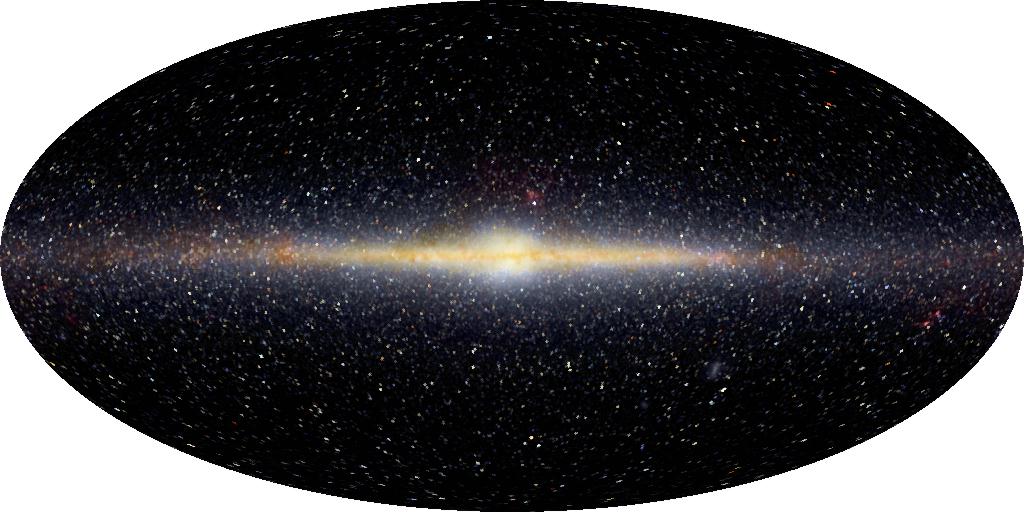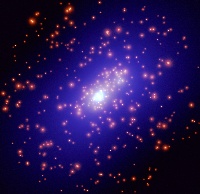Cosmology Primer: Overview
The universe is a big place, filled with surprises, and including realms far beyond everyday experience. To be honest, it's a lot to contemplate in one sitting. On this page of the Primer, we give a quick overview of the basic features of our universe, as understood by contemporary cosmologists. The pages to follow go into more detail about the specific ideas mentioned here.
The most important features of the universe on very large scales can be summarized quite concisely: it's big, it's smooth, and it's getting bigger. When we look into the sky on a clear night, the first things we notice (besides the Moon and possibly the planets) are the stars. Each star is an object comparable to our Sun, although there is quite a range of star types. We live in a collection of stars bound together by their mutual gravitational attraction: the Milky Way galaxy.
But the Milky Way is just one of billions of galaxies in our observable universe; the basic characteristics of this collection are described in the page on the luminous universe. Fortunately, on the largest scales the distribution of galaxies is very similar throughout the universe; this is what is meant by the smoothness of the universe. Most remarkably, distant galaxies are all moving away from each other, as discovered by Edwin Hubble in 1929. This mutual moving-away is described in the page on the expanding universe.
The universe was a different place early in its history. Since the universe is expanding today, in the past it was much more hot and dense, as its constituents were packed more tightly. Traced back sufficiently far, it should be too hot for atoms to exist, as electrons are continually jostled away from atomic nuclei; even earlier, nuclei themselves would be torn into individual protons and neutrons, and the universe should be an incredibly hot plasma of subnuclear particles. If we try to go all the way to the beginning, we would reach a singular point called the Big Bang. A timeline of important events in the history of the universe is provided in the page on the evolving universe.
Winding the picture forward from the Big Bang, we evolve from a hot and dense plasma to the cooled-off universe we observe today. Along the way, there is a brief period when the universe is about one minute old in which protons and neutrons are being synthesized into light nuclei (helium, deuterium, and lithium, along with individual protons comprising hydrogen nuclei). Later, electrons combine with these nuclei into atoms when the universe is about 370,000 years old. It is at this point that the universe becomes transparent, and the ambient radiation streams freely to us today. Light waves get stretched to longer wavelengths as the universe expands, so this radiation has cooled to approximately 3 degrees Kelvin, forming the cosmic microwave background (CMB). This basic framework is verified to high precision by observations today, as described on the page about the early universe.
There is much more to the universe than what is immediately visible. Fortunately, everything gives rise to a gravitational field, so we can detect additional sources of matter and energy by probing for their gravitational effects. It turns out that only about 5% of the universe is "ordinary matter" (the atoms of which stars, gas, dust, and planets are made). About 25% of the universe is "dark matter," a new kind of particle never yet detected in any laboratory here on Earth. A full 70% of the universe is "dark energy," a smoothly-distributed and persistent kind of energy which remains a fundamental mystery of science. The dark energy might be a vacuum energy inherent in spacetime itself, or it might be something even more exotic. The pieces of evidence we have accumulated for dark matter and dark energy, as well as theories proposed to account for them and experiments ongoing to constrain them, are discussed in the page on the dark universe.
The conventional Big Bang model provides an excellent fit to observations, as long as we impose very specific initial conditions at early times: an expanding universe with almost the same density at all points in space, but with small perturbations that eventually grow into galaxies today. Why did the universe start like that? A possible answer is provided by "inflation," which posits a brief period of accelerated expansion at very early times. A related problem concerns the imbalance of matter and antimatter in the universe: why are there more particles than antiparticles? The page on the really early universe discusses the idea of inflation as well as mechanisms to explain the matter/antimatter asymmetry.
It goes without saying that we still have a lot to learn about the universe, but scientists are planning an exciting array of new experiments to push the frontiers of our understanding forward. The page on the measured universe describes the different kinds of experiments under development, as well as some of the most important ones already in operation. We have every reason to believe that new discoveries about the universe will continue to surprise and delight us.
Next: The Expanding Universe

